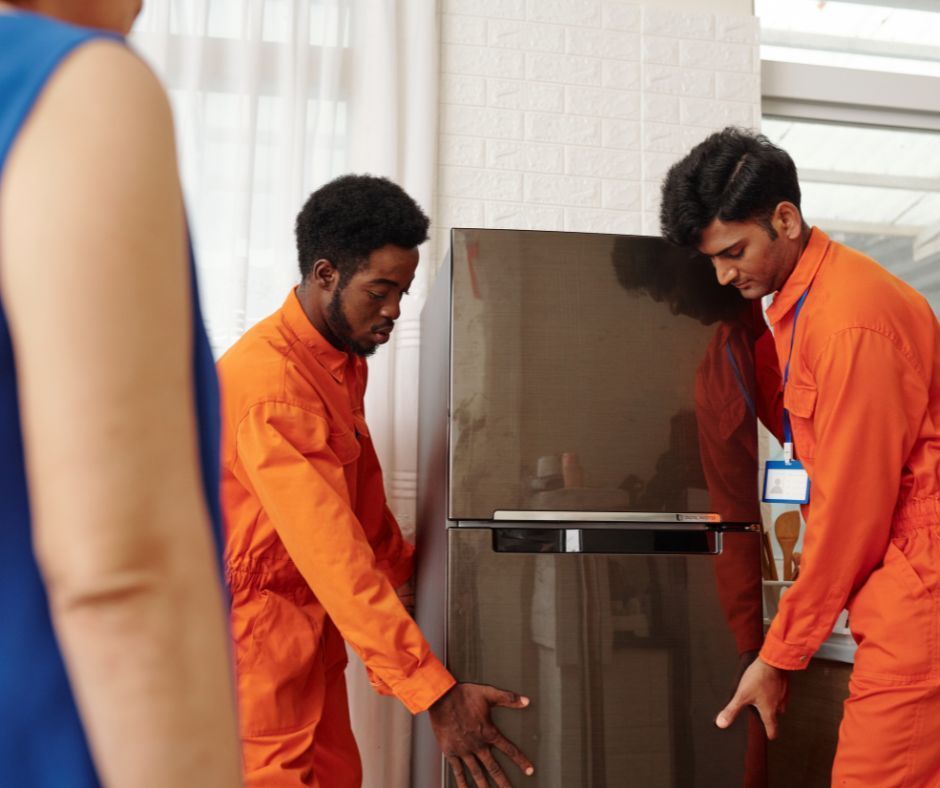
Request a Quote
We will get back to you as soon as possible.
Please try again later.
Most homeowners are hesitant to hire a professional mover to move their appliances. After all, it’s cheaper to do it yourself. Wrong! In this blog post, I’ll explain why DIY appliance moving is bad and discuss what you should consider before trying to do it yourself.
Keep reading to learn more!
What is a DIY appliance moving, and what are the risks involved?
For those unaware, DIY appliance moving involves moving heavy appliances on their own without the help of a professional moving company. Most DIY appliance movers move appliances into homes or offices, while some move appliances between floors or buildings.
The risks of DIY appliance moving are many.
First and foremost, there are the potential injuries that appliances can inflict on movers. Unfortunately, DIY appliances are one of the most dangerous DIY projects. The Consumer Product Safety Commission reported that 45% of deaths associated with small appliance movers involved falls, of which 40% resulted from breaking or tripping over.
Second, moving heavy appliances on your own could lead to damage to your new location. Some appliances, such as dishwashers and refrigerators, have sensitive internal components. Moving these appliances on your own can lead to more serious damage.
Third, DIY appliance movers risk damaging the appliances they are moving, which may become very costly to repair.
Lastly, DIY appliance movers risk being seriously injured or even killed by falling objects or appliances.
Why is it essential to have a professional move your appliances?
Appliances are big, heavy, and awkward.
Hiring professionals is the safest way to make the big move with your appliances.
DIY moving can be risky .
For example, moving appliances with sharp or pointed edges can be dangerous. You could hurt yourself while moving your appliances or accidentally scratch them.
DIY moving can be time-consuming.
Moving appliances is time-consuming. And if you’re moving into a new house or apartment, you might need more time to move all your appliances.
DIY moving can damage your appliances or your home.
For example, if you move appliances by yourself, you can accidentally scratch them or drop them — both of which can damage your appliances.
DIY moving is harder for homeowners with bad backs or bad knees.
Also, moving appliances, burdensome ones, can be challenging for people who can’t stand for long periods.
DIY moving is inconvenient.
Moving appliances on your own can be problematic. You have to take time off work, find parking space, and haul the appliances to your new place on your own.
DIY moving is risky.
For example, if you damage your appliances while moving them, you might have to replace them. And if you have bad backs, bad knees, or are carrying heavy loads, moving appliances can be risky.
Things to keep in mind when planning your DIY appliance move
If you’re moving your appliances to a new home yourself, there are a few essential things you’ll need to keep in mind:
Assess the services your current provider provides . For example, keep your existing services active if you’re moving an appliance that services your home.
Is your home’s electrical system up to code? Moving appliances into an older home can be dangerous if your home’s electrical system is outdated. If your home’s electrical system needs to be updated, you may need to hire an electrician to upgrade your wiring before moving any appliances.
Disconnect all appliances. If your appliances are hardwired to an outlet, you’ll want to disconnect them before moving them into your new home. If you’ve installed a new appliance, turn the power off at the service panel before moving the appliance into your home.
Pack your appliances properly . Moving into a different home means you may have to unpack and organize your appliances — which can be stressful. If you’re moving large appliances, you may want to hire professional movers or ask a friend for help. If you’re moving small appliances, you may want to wrap each appliance tightly in a blanket or moving pad before placing it into boxes.
Clean your appliances before moving them in . Before moving appliances into your new home, thoroughly vacuum the inside of your fridge, oven, dishwasher, washing machine, and dryer.
How to find a qualified and experienced appliance mover?
If you’re moving a house or apartment, you may need to hire an appliance moving company to transport your large appliances.
Research the companies. When looking for appliance movers, it can be helpful to do a Google search for “appliance movers near me” to see which companies are in your area.
Ask neighbors, friends, and family for recommendations. Some of your friends or your neighbors may be moving soon if you’re moving locally. Ask them who they hired to transport their appliances, and if possible, ask for a recommendation.
Check the Better Business Bureau. When researching these companies, it’s also a good idea to check for any complaints on the BBB website.
Research the companies online. In addition to doing a Google search, it’s also a good idea to check online review sites such as Yelp or Google Reviews to see what previous customers had to say about the appliance movers they hired.
Ask more questions. Once you have a list of a few companies, you should ask them more questions. When you ask questions, you must be clear about what you’re asking. For example, the last thing you want is for your appliances to get damaged during the move, so it’s essential to ask about the insurance policy that the company has and whether they guarantee their work.
Ask for references. You should also ask the companies for a list of references. This can be especially important if you’re booking a move at the last minute.
FAQs about DIY appliance moving answered by experts in the field
Moving appliances in DIY fashion is not without its risks, and expert movers have put together this FAQ to address some commonly asked questions:
Do you have to wear protective equipment when moving appliances?
Although moving appliances yourself is tempting, wearing protective gear is always a good idea.
How do I keep the appliances safe while moving?
If you’re packing your appliances on your own, make sure to follow these steps:
First, pack the appliances like they are fragile. Soft foam and plastic packing material and furniture pads work well.
Next, wrap the appliances in bubble wrap and furniture pads. If possible, keep the appliances in their original packaging. Next, place the appliances in boxes and securely tape the sides and bottom.
Do I need to remove the screws from the appliance?
Professionals will sometimes remove the screws from appliances before moving them. However, removing the screws yourself isn’t safe unless you know how to do it safely and correctly.
How do I move appliances by myself?
Perhaps you don’t want to wear protective equipment or schlep appliances up and down stairs, but you still want to move them yourself. Follow these expert tips for moving appliances on your own.
What should I know when moving appliances?
In addition to learning essential safety tips for moving appliances, it can be helpful to know the specifics of your moving appliances. For example, a refrigerator needs its defrost drain plugged in when moving.
What shouldn’t I do when moving appliances?
As its name suggests, DIY appliance moving can be tricky. Avoid these common mistakes when moving appliances on your own.
Moving appliances is a complicated job that requires specific safety procedures. If you’re thinking about moving appliances yourself, think again. Do yourself a favor and hire a professional mover. In this blog post, I’ve explained why DIY appliance moving is bad and outlined the questions you need to ask before hiring a mover.
If you need a professional movers who will handle your small jobs moving, you may call us at (855) 715-6683 we are happy to help you.
The post Why DIY Appliance Moving is a Bad Idea? appeared first on Treasure Moving.

12140-A Parklawn Dr, Rockville, MD 20852
(855) 715-6683
info@treasuremoving.com
Treasure Moving Company | All Rights Reserved
USDOT #(855) 715-6683 - MC #(855) 715-6683
